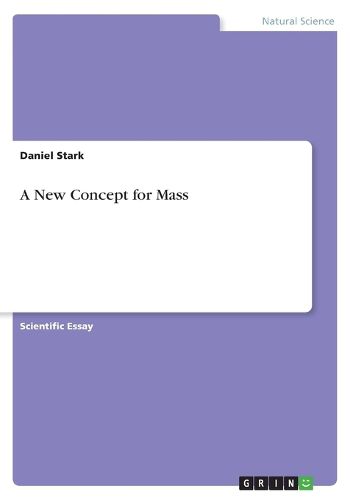Readings Newsletter
Become a Readings Member to make your shopping experience even easier.
Sign in or sign up for free!
You’re not far away from qualifying for FREE standard shipping within Australia
You’ve qualified for FREE standard shipping within Australia
The cart is loading…






Scientific Essay from the year 2019 in the subject Physics - Theoretical Physics, language: English, abstract: This paper proposes a model for mass that combines two theories. Gunnar Nordstroem's theorized mass is dependent on the scalar gravitational field and Stark theorized that our elementary particles are composed of fundamental excited Dark Matter (DM) particles. Dm excitation theory is that our elementary particles are DM particles. DM particles are excited via collisions, creating closed Electromagnetic (EM) oscillations about a DM particle, transforming the DM particle into our elementary particles. DM particles are the fundamental particle. Nordstroem's theory rivaled Einstein's relativity. Nordstroem describes the gravitational flux as scalar rather than a vector as treated by Einstein. Nordstroem's theory failed to mathematically demonstrate photon refraction when passing by stars whereas Einstein's relativity predicted the refraction, which resulted in acceptance of Einstein's theory. However, reevaluation of Nordstroem's theory is warranted because new observations are correctly predicted by Nordstroem's theory and not by Einstein's relativity. Examples are: (a) the expanding, accelerating universe, (b) galaxy rotation, (c) variation of the big G gravitational constant. The variation of G is currently a topic for experiments.
$9.00 standard shipping within Australia
FREE standard shipping within Australia for orders over $100.00
Express & International shipping calculated at checkout
Scientific Essay from the year 2019 in the subject Physics - Theoretical Physics, language: English, abstract: This paper proposes a model for mass that combines two theories. Gunnar Nordstroem's theorized mass is dependent on the scalar gravitational field and Stark theorized that our elementary particles are composed of fundamental excited Dark Matter (DM) particles. Dm excitation theory is that our elementary particles are DM particles. DM particles are excited via collisions, creating closed Electromagnetic (EM) oscillations about a DM particle, transforming the DM particle into our elementary particles. DM particles are the fundamental particle. Nordstroem's theory rivaled Einstein's relativity. Nordstroem describes the gravitational flux as scalar rather than a vector as treated by Einstein. Nordstroem's theory failed to mathematically demonstrate photon refraction when passing by stars whereas Einstein's relativity predicted the refraction, which resulted in acceptance of Einstein's theory. However, reevaluation of Nordstroem's theory is warranted because new observations are correctly predicted by Nordstroem's theory and not by Einstein's relativity. Examples are: (a) the expanding, accelerating universe, (b) galaxy rotation, (c) variation of the big G gravitational constant. The variation of G is currently a topic for experiments.